Lecture
On the pages of this section, we dealt with the device and the principle of operation of a satellite dish (satellite dish). There was considered a parabolic asymmetric antenna with a shifted focus, such as Offset , that is, an offset satellite antenna ( Fig. 1 ).
(parabolic asymmetric)
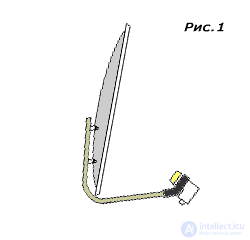
There is another very common type that you may also encounter, this is a direct-focus parabolic symmetric satellite dish ( Fig. 2 ), or simply a straight-focus antenna. They differ both in design and in signal transmission.
(parabolic symmetric)
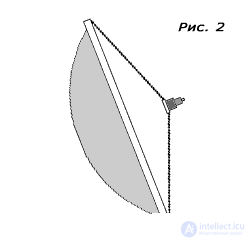
By the principle of operation, these two satellite antennas differ in the direction of the signal reflected from their reflector, that is, from the very mirror of this antenna.
At the offset satellite antenna , the signal coming from the satellite hits the inside of the spherical mirror of the antenna at a certain angle ( Fig. 3 ). Having reflected, the signal is focused on the converter feed located below.
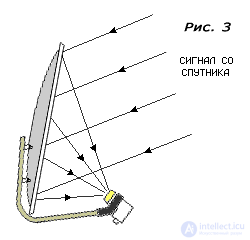
Signal transmission at the offset satellite dish .
It turns out that the focus of the offset satellite antennas is located to the side, that is, as if shifted to the lower part of the structure. Therefore, they are called asymmetric (no symmetry).
At the direct-focus satellite antenna , the signal coming from the satellite is focused in the diametrical center of the spherical mirror. Therefore, it is called symmetric ( Fig. 4 ).

Signal flow from a direct-focus satellite dish .
As seen on the above images, the essential difference between offset and direct-focus satellite dishes is , of course, their design. But this is just the technical side. The most significant difference will be their position.
A direct-focus antenna, as if lifted its "nose" to the top, and looks strictly in the direction of the satellite. The offset antenna has a certain inclination. From the side it seems that she looks down, but the bottle catches the reflection from the earth. But ... as you approach the equator , instead of this slope, its mirror will already be lifted.
Before acquiring a satellite dish , you will need to make a choice on which type of construction to stop, or which antenna design is better to use, specifically for your case. Therefore, we will further consider what advantages and disadvantages the offset and direct-focus satellite dishes will have .
Each of these types of satellite dishes has its pros and cons. Some of the important advantages and disadvantages of offset and direct-focus satellite dishes include:
1 . At the offset satellite antenna , the focus of the signal reflected from the reflector is shifted to the side. This significantly and positively affects its unhindered passage to the converter feed. And in a direct-focus antenna, the signal is hindered by the passage of the signal, both its posts holding the converter and the receiver itself.
2 In various climatic conditions, whether it is raining or snowing, the offset satellite antenna will have a significant advantage. This is due to the position of the reflector itself. When viewed from the side, at a offset antenna the reflector acts as a bottle, as for example, on an open telephone booth. Therefore, precipitation does not fall on the reflected surface of the antenna itself, but only on its rear part ( Fig. 1 ).
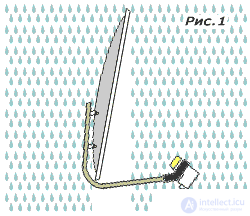
And the direct-focus satellite dish , ate as seen from the side, resembles the shape of a lowered bucket, thus providing an antenna mirror not protected by anything else than any precipitation. And the higher the satellite we need to receive the signal is located, the more precipitation will accumulate at the bottom of the mirror ( Fig. 2 ).
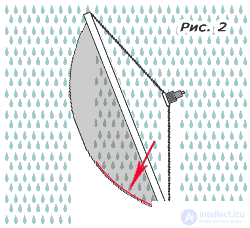
In winter, the right-of-focus satellite dish must be periodically cleaned of snow that has fallen inside. What will be problematic if the antenna itself is in a remote place.
But there is some nuance in favor of the direct-focus satellite dish . As it can be seen from the figure below ( Fig. 3 ), the converter irradiator looks below the horizon, and it turns out that with its body it protects the receiving part of the irradiator from snow or rain.
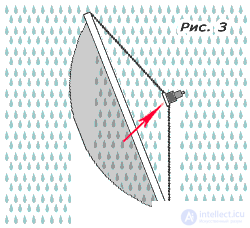
With a direct-focus satellite dish , the feed is protected from rain.
At the offset satellite antenna , even though the reflector has a certain inclination, the converter still remains open ( Fig. 4 ).
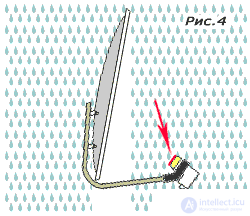
In this case, for example, during rain, with a greater accumulation of water droplets on the irradiator, the reception of the signal becomes unstable, and if the signal from the satellite is weak enough, then at times it is not at all possible. In winter, a little worse. The snow accumulated on the irradiator also prevents the signal from passing, and when you consider that the snow is sometimes wet, then during frosts, the converter also starts to ice up.
But as practice has shown, thanks to our craftsmen, with this lack of offset antenna, it is partially possible to cope. This can be done by protecting the converter feed itself, while making a small visor from a plastic bottle .
From all this we can conclude that the offset satellite antenna , less serviceable design.
In principle, if you take into account all the nuances of receiving a signal at the offset antenna, you should also know that the closer your location is to the equator, the higher the rise of the antenna’s mirror above the horizon. This means that with sufficiently strong rain, the water flowing along the reflecting surface of the mirror will prevent the reflection of the signal on the converter feed. In winter, snow will be an obstacle to the signal.
3. Another advantage of the offset satellite antenna , in front of the direct focus, will be the distribution of the center of gravity . In offset, the bulk of the antenna is distributed on the bracket, to which the antenna itself and the converter with the feed are attached. Thereby, redistributing the main center of gravity to the bottom of the whole structure, and thus making it more stable during wind gusts.
This is of course not all the differences between the offset and direct focus antenna, but only the main ones, but this is quite enough to make the choice of which satellite dish you should get. I would also like to say that offset antennas are more common among home users of satellite TV broadcasting, as they are less serviced and more conducive to our “apartment” conditions.
Comments
To leave a comment
The television. Theory. Satellite
Terms: The television. Theory. Satellite